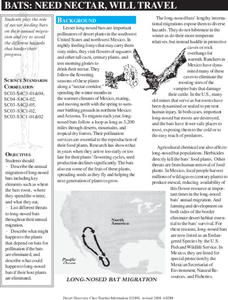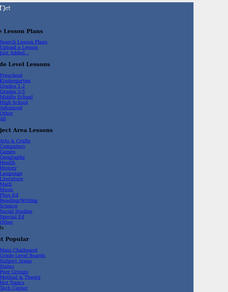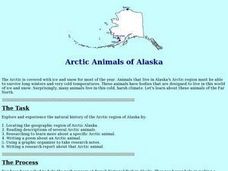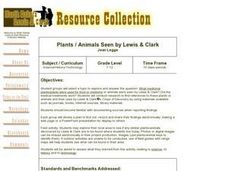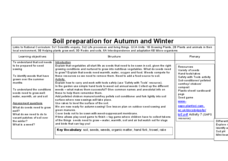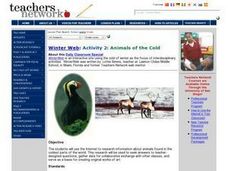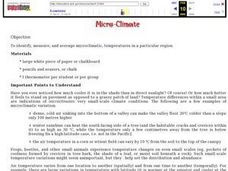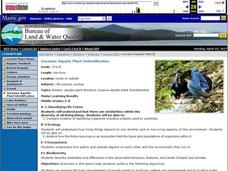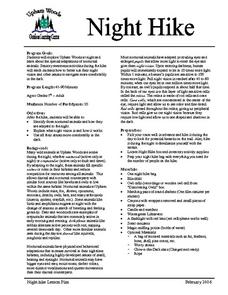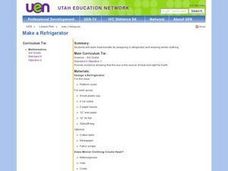Curated OER
Bats: Need Nectar, Will Travel
Beginning wildlife biologists become adult bats, baby bats, snakes, owls, bobcats, or land-clearing developers in a grand role-playing activity. In a large open space, they play a game in which they move to designated areas based on what...
Curated OER
Hibernating Animals
Students recognize some hibernating animals and create a 'den' for them by gluing scraps on the insides and outsides of boxes. They write letters to their sleeping animals to read when they are awakened.
Curated OER
Why Do Geese Fly South For the Winter?
Fifth graders examine migration by tracing animal migration routes on a map. In this animal life lesson, 5th graders observe a map of North America and read about the migration patterns of geese. Students trace the path most...
Curated OER
Arctic Animals of Alaska
Students explore the natural history of arctic Alaska through lecture and discussion. They write poems and complete research papers about Arctic animals.
Curated OER
Plants / Animals Seen by Lewis & Clark
Students conduct research to find references to plants or animals and their uses by Lewis & Clark's Corps of Discovery by using materials available such as journals, books, internet sources, library materials. Groups create a...
Curated OER
Soil Preparation for Autumn and Winter
Students determine how and why soil needs to be prepared for the fall and winter seasons. In this agriculture instructional activity, students determine how to use gardening tools safely. They show how to work with compost material and...
Curated OER
Read Aloud Lesson Plan: Water for One, Water for Everyone
Students listen to a read aloud about African animals as they access a watering hole. They discuss the characteristics of Africa such as the temperature, it distance from the students, and lifestyle of the animals. They talk about how...
Curated OER
Animals of the Cold
Students access the Internet to research information about animals found in the coldest parts of the world. They gather data for collaborative exchange and research answers to teacher designed questions. They create original works of art...
Prince William Network
The Incredible Journey
Divide your school gym into breeding grounds and non-breeding grounds so that your zoologists can play a game simulating the seasonal migration of shorebirds. Players pick one of the included game cards and follow its directions, which...
Curated OER
Birds and Coffee
Fifth graders identify the changing seasons with how they affect animal and human behavior. They explain what migration is and why many birds migrate south for the winter. They then trace the coffee sold in their neighborhood and in...
Curated OER
Micro-Climate
Atmosphere aces investigate the microclimates that exist within a larger area. They use a thermometer to record the varying temperatures and identify the microclimates on a map that they have drawn. This exercise helps them to understand...
Curated OER
Life in the Arctic
Pupils create a model of an arctic animal. In this animal adaptation lesson plan, students research an arctic animal, create a 3-D model of their animal, and explain the physical characteristics animals in the arctic need to survive.
Curated OER
Develop a Bird Feeder Watch List
Students explore biology by identifying animals on their school ground. In this bird species lesson, students create and utilize a simple bird feeder to attract birds near their classroom at which point they observe the color, size and...
Curated OER
Invasive Aquatic Plant Identification
Students observe aquatic plants and animals and identify their systems. For this plants and animals lesson plan, students compare systems of organisms and orally express how plants and animals rely on each other.
Curated OER
Wilderness Classroom
Pupils visit an online website to complete animal and plant science activities. In this online education lesson plan, students visit the Wilderness Classroom website and follow the instructions and plans to learn about the science...
Curated OER
Night Hike
Students explore Upham Woods at night and investigate about the special adaptations of nocturnal animals. They identify three nocturnal animals and how they are adapted to the night. Students explain what night vision is and how it works.
Curated OER
Classifying Dog Breeds
Students classify dog breeds. In this animal science instructional activity, students research various breeds of dogs on the Internet and classify breeds into small, medium, and large breeds. Students illustrate their classification...
Curated OER
Pond Animals During The Seasons
Pupils interact with a CD Rom to examine pond life. In this pond life lesson plan, students access a CD Rom entitled "Sammy's Science House CD Rom" in order to see pond life during the different season of the year. They study the...
Curated OER
Oddball Out: Animals that are Different
In this science worksheet, students analyze 4 pictures of animals in a row. Students circle the animal which is different from the others. Answers are provided at the bottom of the page. There are 4 rows of animals.
Curated OER
Let's Get Warm!
Young scholars investigate various methods that animals use to warm up in cold weather. They also explore the science principals involved. They then identify a human parallel, discuss what we can learn from nature, and create multimedia...
Curated OER
Habitats of the World
Students discover that the Earth supports many different animal habitats. In this habitat lesson students research different habitats of the world. Students show how the animals in their habitat are adapted.
Curated OER
Make a Refrigerator
Third graders explore the concept of heat transfer as experienced in wearing winter clothing and analyzing the refrigerator.
Curated OER
The American Prairie
Students design an animal. In this prairie lesson, students learn about physical and behavioral adaptation, locate the Great Plains on a map, and design an animal that would be perfectly adapted for life on the prairie. ...
Curated OER
Blue Planet: Frozen Seas
Students study the animals from the Arctic and how they have adapted. For this ocean lesson students create a poster about their given animal and present it to the class.
